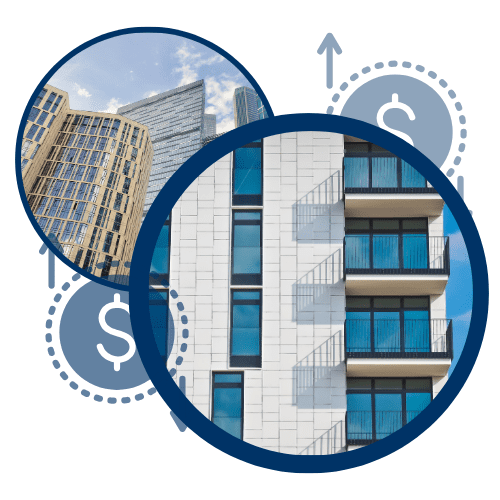Market Commentary | July 29th, 2024
Week in Review…
Broad equity markets finished mixed for the week with cyclical names continuing to outperform technology and momentum.
- The S&P 500 was down for the week, losing 0.83%
- The Dow Jones Industrial Average was up by 0.75%
- The Nasdaq Composite was down by 2.08%
- The 10-year Treasury closed at 4.20%

The U.S. existing home sales numbers were released on Tuesday for the month of June, gauging the demand and health of the U.S. housing market. June showed a significant decrease in the number of sales with a reading of 3.89 million, implying a weakening market. The following day, the new home sales number, which includes all residential buildings not listed in the previous release, reported a 64% decrease in sales from the previous month. Economists will be watching to see if the housing market continues to cool down.
On Wednesday, the Manufacturing and Services Purchasing Managers’ Indices (PMIs) revealed whether the recent expansion trends within these sectors continued or not. The services industry continued to show signs of expansionary tendencies; however, the manufacturing industry took a turn in the trend with a reading of 49.5, lower than its previous reading of 51.7.
On Thursday, U.S. gross domestic product (GDP) was brought into the spotlight. The U.S. economy expanded at a 2.8% annualized rate in the second quarter, beating the forecasted 2% growth projection and outpacing last quarter’s 1.4% growth rate. The composition of growth showed broad strength across the economy with notable impacts from consumer spending and private investment. That same day, the initial jobless claims numbers were released. The reading showed 10,000 fewer claims for the week compared to the previous week. However, the four-week moving average for claims remained virtually unchanged. Lastly, the Personal Consumption Expenditures (PCE) Index, a Fed-favored inflation measure, was released on Friday. The reading showed a 0.1% increase change month-over-month, which was in-line with expectations.
Spotlight

A Closer Look at the U.S. Commercial Real Estate (CRE) Market
The U.S. Commercial Real Estate (CRE) market is navigating a complex landscape characterized by mixed economic indicators and evolving property sector dynamics. Despite facing challenges, there are signs of stabilization and potential growth opportunities as the market adapts to new realities.
The Federal Reserve has kept interest rates between 5.25% and 5.50% since July 2023 after 11 rate hikes to combat inflation. Predictions for rate cuts in 2024 have become uncertain as the Fed takes a cautious stance, focusing on inflation trends. Current monetary policy suggests that U.S. commercial real estate values may be stabilizing, although performance varies widely by market and property type. While overall performance is negative, some segments are showing flat or positive returns, indicating cautious optimism for the near term.

Transaction Volumes and Property Prices
The U.S. CRE faced significant challenges in 2023, particularly in the fourth quarter. According to Green Street’s Commercial Real Estate Year-end 2024 update, transaction volumes in Q4 2023 reached their lowest point for the year, marking a 60% year-over-year decline and a 35% quarter-over-quarter decrease. Overall transaction volumes for 2023 fell well below long-term averages, with most property sectors experiencing substantial drops. CBRE data indicates that apartments were especially impacted, with volume declines of approximately 50%.

Source: Mercer Research
Commercial property prices continued their downward trajectory from their 2022 peak. Green Street’s Commercial Property Price Index reported a 21% decline from the March 2022 peak, with office assets experiencing the most significant drop at 24% year-over-year. In contrast, apartment properties showed a slight improvement in transaction pricing, with a 2% quarter-over-quarter increase.
Performance Metrics
In Q4 2023, the NCREIF NFI-ODCE Fund Index, which encompasses 25 funds with a total of $220 billion in core U.S. real estate assets, reported a gross total return of -4.8%. This figure consists of a 1.0% income return and a -5.8% capital appreciation. Over the trailing year, the gross return for Q4 was -12.0% (-12.7% net of fees). Consequently, all sectors, with the exception of hotels, experienced negative total returns net of fees in 2023. The office sector was the weakest performer, delivering a -17.6% return, while hotels rebounded significantly, finishing the year with a 10.3% return.

The analysis of the NCREIF ODCE NPI Fund Index shows a consistent trend in return sources since mid-2022, primarily driven by income returns despite rising interest rates. This trend persisted through the first quarter of 2024. The NPI Snapshot Report for Q1 2024 highlighted a decline in total gross returns, with an annualized total return for 2023 recorded at -12%. This downturn was largely due to a significant decrease in property values, as appreciation returns plummeted by -15.20% over the year. Although income returns remained positive, they were modest, at 3.62%.

The NCREIF Fund Index – Open End Diversified Core Equity (NFI-ODCE) is a capitalization-weighted index that tracks the gross investment returns of open-end commingled funds pursuing a core investment strategy in private equity real estate. Established on December 31, 1977, it includes funds that typically employ low-risk, low-leverage strategies, focusing on stable properties diversified across the U.S.
Property value adjustments have historically resulted in significant total returns within the open-end core real estate market. Following economic downturns, unlevered returns for NCREIF ODCE funds have typically ranged from 12.5% to 15.5%. However, recent economic challenges have led to heightened redemption requests across nearly all open-end real estate funds, with many funds reporting redemptions exceeding 15% of net asset value (NAV) as of December 31, 2023. The COVID-19 pandemic and the ensuing market fluctuations caused an over-allocation in real estate, prompting investors to rebalance their portfolios through redemptions, a situation further intensified by the “denominator effect.”
Research from Mercer indicates that historically, after downturns such as those in the early 1990s, the early 2000s tech crash, and the Global Financial Crisis, the NCREIF NFI-ODCE index achieved net returns between 11.3% and 14.0% over the following five years, translating to gross returns of approximately 12.99% to 14.01%. Despite negative returns in the first quarter of 2024, there may be indications of potential recovery on the horizon.

Source: Mercer Research
Demand Drivers
Mercer reports that despite recent return volatility, the real estate sector remains strong, particularly outside of office properties, with vacancy rates stable. The retail sector, especially necessity-based stores, is recovering, while portfolio managers are shifting investments to industrial and multifamily sectors due to high demand from e-commerce and rising home-buying costs. Additionally, new investment strategies are emerging, focusing on logistics, self-storage, life science labs, and alternative housing to achieve strong returns with lower risk.
Week Ahead…

The Consumer Confidence Index for the month of July will be released on Tuesday by the Conference Board. The readings from the previous two months have been growing, indicating an increase in consumer confidence in the economy. The upcoming reading is forecasted to decline slightly. That same day, the American Petroleum Institute (API) will release their Weekly Crude Oil Stock measurement. An increase in inventories implies weaker demand and a possible decrease in prices. On the other hand, an increase in demand could lead to an increase in petroleum prices.
Midway through the week, the ADP’s employment report will help gauge the health of the labor market. First, ADP will publish their National Employment Report measuring the monthly change in non-farm, private, payroll data. Additionally, the Job Openings and Labor Turnover Survey (JOLTS) job openings report will be released. Currently average hourly earnings for July are forecasted to be in line with the percentage change from the previous month, at 0.3%.
Investing involves risk. Depending on the different types of investments there may be varying degrees of risk. Socially responsible investing does not guarantee any amount of success. Clients and prospective clients should be prepared to bear investment loss including loss of original principal. Indices mentioned are unmanaged and cannot be invested into directly. Past performance is not a guarantee of future results.
The Dow Jones Industrial Average (DJIA) is a price-weighted index composed of 30 widely traded blue-chip U.S. common stocks. The S&P 500 is a market-cap weighted index composed of the common stocks of 500 leading companies in leading industries of the U.S. economy. The NASDAQ Composite Index is a market-value weighted index of all common stocks listed on the NASDAQ stock exchange.
Securities offered through Cambridge Investment Research, Inc., a broker-dealer, member FINRA/SIPC, and investment advisory services offered through Cambridge Investment Research Advisors, Inc., a Registered Investment Adviser. Both are wholly-owned subsidiaries of Cambridge Investment Group, Inc. V.CIR.0724-2614
